Ancient Origins
A Cabman’s shelter was a special place in London, England during the second half of the 19th century. These types of shelters were intended to be places where a cabman could obtain hot food and drink whilst working and though few have remained, they have an iconic status even today.
Although these shelters proved to be very popular in the past, they have been in decline. Today, only a small number of these historic buildings remain. Nevertheless, they are currently Grade II listed buildings, which means that they are protected by law due to their status as heritage assets.
Obelisk, Cabmen's Shelter and Telephone Boxes, Market Place, Ripon. (Tim Green/CC BY 2.0)
A Philanthropic Act
The cabmen shelter was an idea conceived in 1875. The story goes that in January of that year, George Armstrong, the editor of London newspaper The Globe, needed a cab to take him to work. Unfortunately, his servant was unable to find one, and Armstrong was informed that due to the blizzard, all the available cab drivers (who, during that period of time, drove hansom cabs) were taking shelter in a nearby pub.
According to one source, the cabmen were drunk as well, as they were indulging in alcohol whilst waiting for the blizzard to pass and were therefore unable to work. As a result of this incident, Armstrong brought together a group of philanthropists, and established a charity known as the Cabmen’s Shelter Fund.
A cabman. From 'Street Life in London', 1877, by John Thompson and Adolphe Smith. (Public Domain)
The purpose of this charity was to offer cab drivers a place where they could have food and drink, take a break, and seek shelter from bad weather during their working hours.
A cabman’s shelter is easily recognized, as it is small and painted green, Dulux Buckingham Paradise 1 Green, to be precise. The Metropolitan police specified that the size of each shed may be no larger than a horse and a cart, as that they were placed on the public highway. The cost required to build a cabman’s shelter was £200 each, and many of these were paid for by local philanthropists. The first cabman’s shelter was established on Acacia Avenue, St John's Wood (close to George Armstrong’s home), in 1875. Between then and 1914, 61 cabmen’s shelters were established
The green shelter belonging to the Cabmen's Shelter Fund in Russel Square, Bloomsbury London Borough of Camden. (Ethan_Doyle_White/CC BY SA 4.0)
Features of a Cabman’s Shelter
Within each shelter was a working kitchen, in which an attendant could prepare meals and hot drinks for the cabmen who came to the shelters. Alcohol, by the way, is strictly forbidden in the cabmen’s shelters. The sheds are also equipped with tables and benches, and, in spite of its small size, have enough space within them to accommodate up to 10 customers at a time. Although the cabmen’s shelters had a certain level of standardization, it may be added that their quality depended on the area they are located in.
Over the decades, the cabmen’s shelters served not only cab drivers, but also various notable characters. For instance, during the 1890s, bohemian poets such as Ernest Dowson frequented these shelters. According to one writer, these poets would visit such sheds at four o’clock in the morning and would order bacon and eggs. It was not because they wanted this dish at that time, but merely because the bourgeoisie were not doing that.
Portrait of Ernest Dowson. (Public Domain)
The most enigmatic figure known to have been a customer of a cabmen’s shelter is a certain doctor by the name of J. Duncan, who claimed that he was responsible for the murders committed by Jack the Ripper. As he seemed drunk, however, the attendant at the shelter, as well as the other patrons there, did not pay attention to him. Having had his meal, Duncan left the shelter, and was never heard of again.
Things have changed for the cabmen’s shelters since Armstrong’s days. For a start, there are only 13 of these sheds remaining. These include the ones on Kensington Park Road, Russell Square, and Grosvenor Gardens. These shelters, incidentally, are still managed by the Cabmen’s Shelters Fund, and are today Grade II listed buildings.
Although the shelters initially served cab drivers only, today, they may be patronized by the general public as well. Nevertheless, the ‘cabbies only’ rule is still enforced, and therefore only cab drivers are allowed to go inside these shelters. The general public, on the other hand are only allowed takeaways.
Top Image: Cabmans Shelter, Russell Square. Source: N Chadwick/CC BY SA 2.0
By Wu Mingren





No comments:
Post a Comment